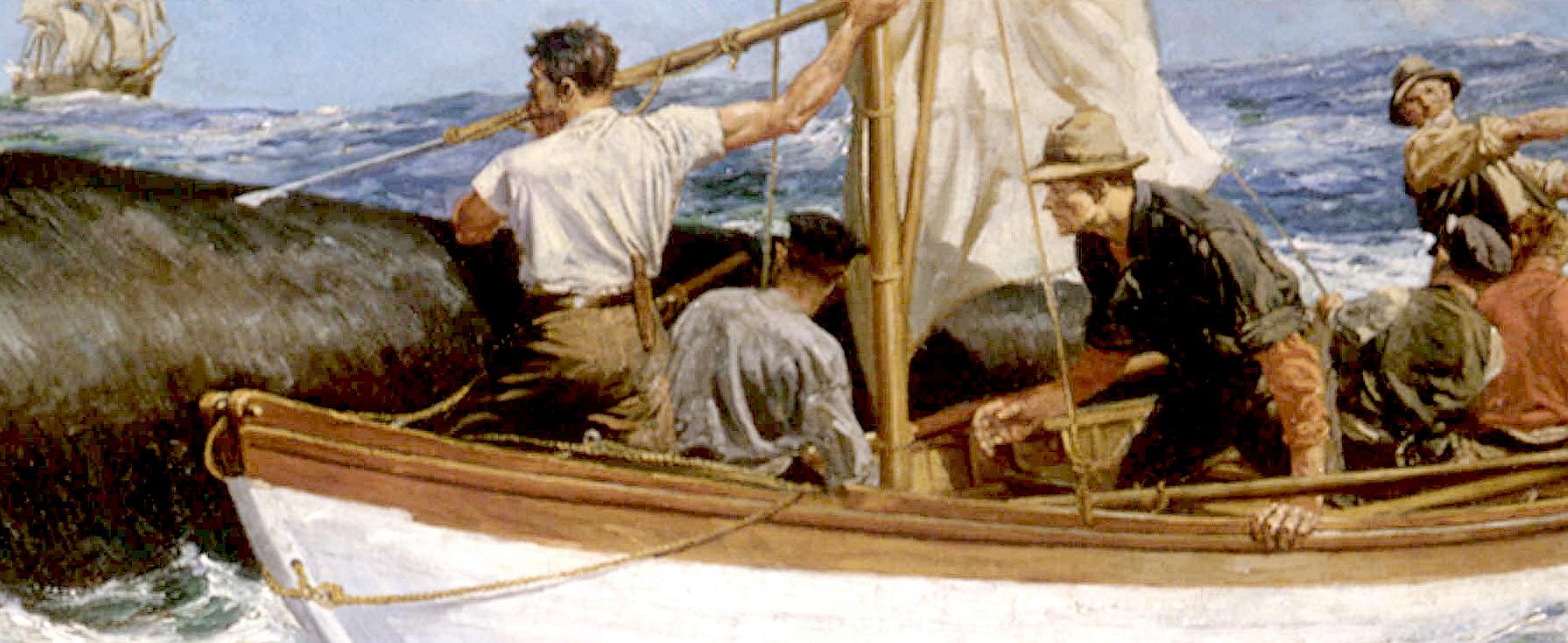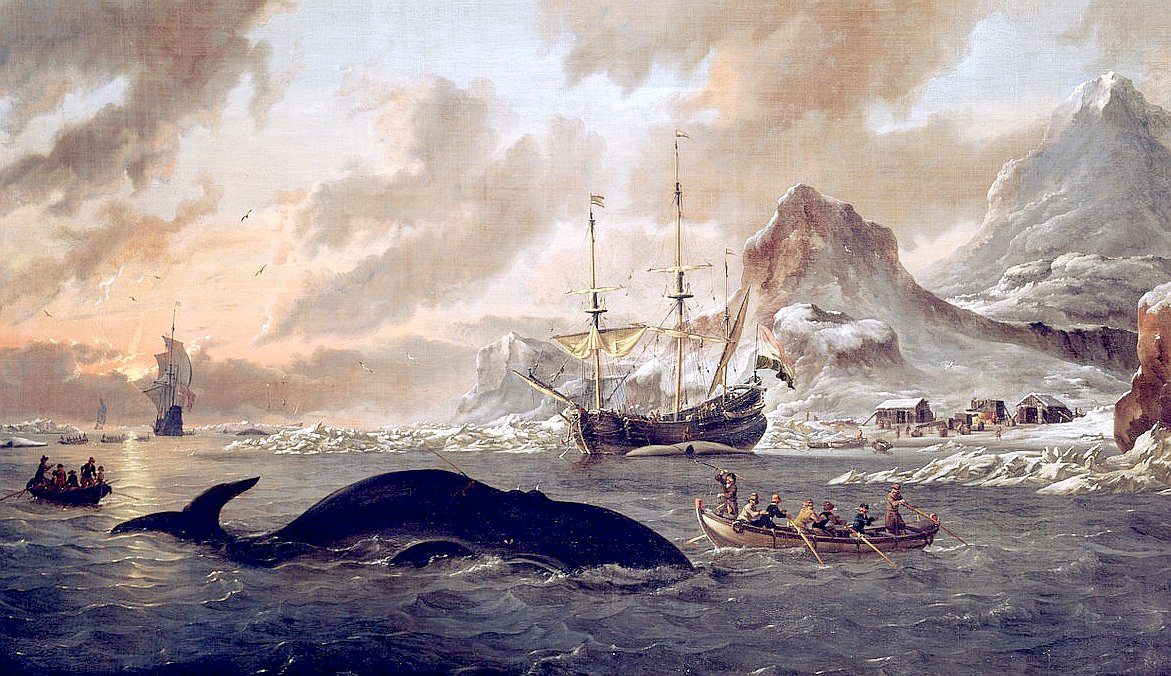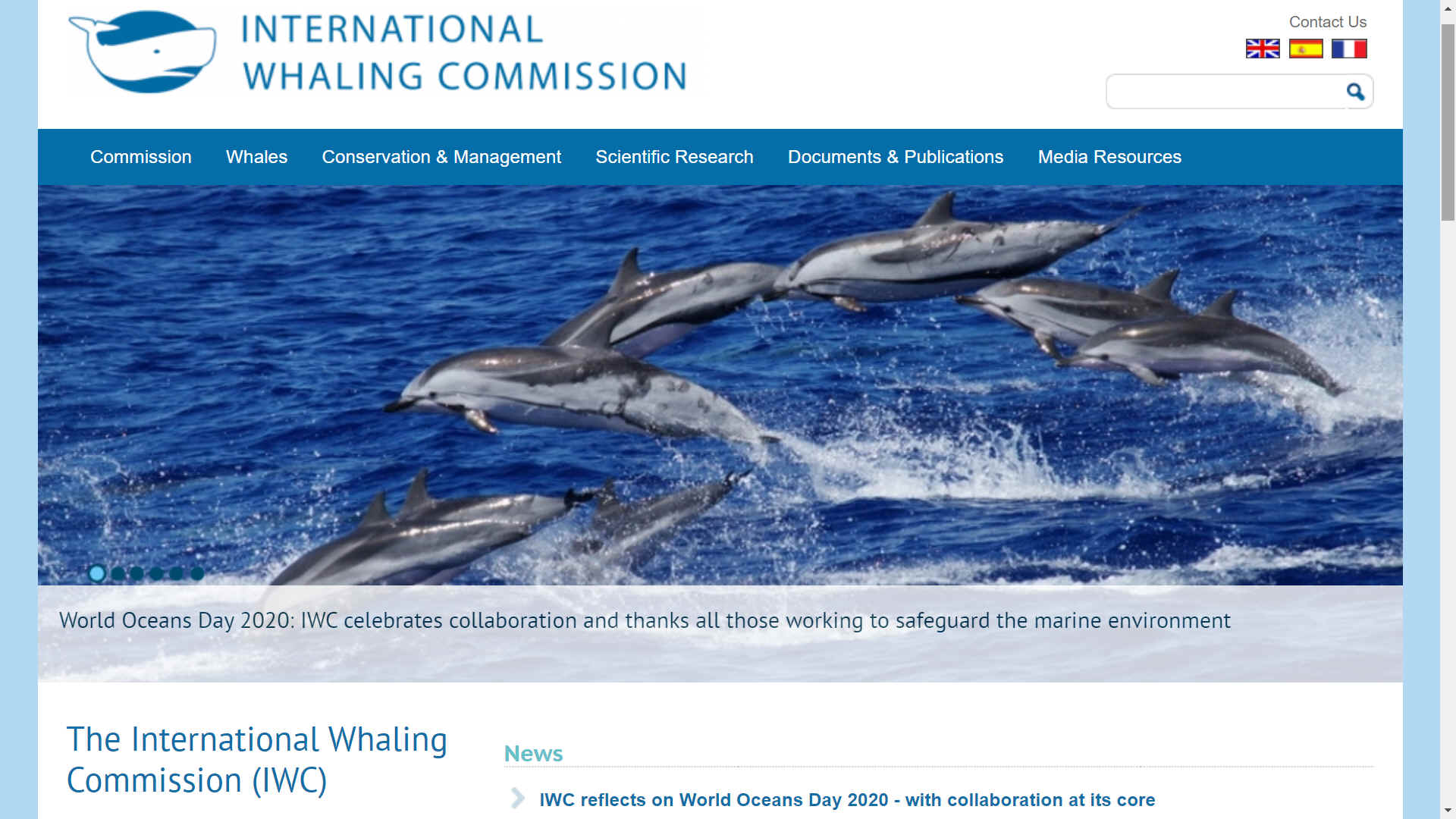
Whalers in for the killing
of a Right Whale, harpooneer ready to strike a death blow.
Whale oil provided fuel for lighting and lubrication for the gears of the industrial revolution, until it was replaced by
petroleum products in the mid-nineteenth century.
Until then the money was in whales - and money is the root of all evil.
By the late 1930’s 50,000 + whales were being killed annually.
In
the United States the whaling industry ranked ninth in overall value to the economy at its height in the mid-1840s. The documentation of that industry is extensive; the data
in many archives combines information from many sources including logbooks, journals, ship registers, newspapers, business papers, and custom house
records as to why whales were hunted:
“Abundantly laden with the riches of the ocean”
Whaling was an exceptionally dangerous business both physically and economically. In the Yankee whale fishery injuries and death were common to almost every voyage. Many vessels were lost. Few individuals got rich whaling and most of those were owners and agents. The answers to why so many people went whaling are many and varied but the underlying principle is that whale products had a strong commercial value if one knew how to exploit it.
“Success to the old Marcella may she speedily return to her original haven abundantly laden with the riches of the ocean.”
Original verse from the journal of Henry Smith kept aboard the bark Marcella of New Bedford, 1840-1841, Benjamin Ellis, master. (KWM # 742)
In Men and Whales, Richard Ellis writes that, until the beginning of twentieth-century, whaling was considered an admirable
occupation:
“. . . it is only through the lens of hindsight that the whaleman’s job becomes malicious or cruel. . . Oil was needed for light and lubrication; baleen was needed for skirt hoops and corset stays. That whales had to die to provide these things is a fact of seventeenth-, eighteenth-, and nineteenth-century life. . .“

WHALE
MONEY PRODUCTS
The primary products of the Yankee whale fishery were sperm oil, spermaceti, whale oil and whalebone and occasionally ambergris if any were discovered.
Sperm oil
- Oil from sperm whale blubber otherwise known as body oil is of a light straw color. It has particular qualities separating it from almost any other type of oil. One in particular is that it retains its lubricating qualities in extreme temperatures making it ideal for light, rapid machinery. Another feature is its superb qualities of illumination. It burns very clearly and brightly and without smoke or odor. Great quantities of sperm oil went into public and private lighting as well as lighthouses. A byproduct of the sperm oil refining process was high quality soap. About half of the crude sperm oil obtained by American vessels at the height of the fishery was exported to other countries.
Spermaceti
- Unlike any other whale oil apart from sperm whale body oil and the material found in the head of the bottlenose whale (Hyperoodon ampulatus) spermaceti is a liquid wax. It was known as “head oil” or “head matter” as it was found in the heads of sperm whales where its true anatomical function is still debated. While in the head it is a rose-tinted, semi-transparent liquid that crystallizes upon contact with the air. It was barreled separately from any other oils obtained in the fishery. This material was the most valuable product of the Yankee whaling industry as it has a high melting point and burned cleanly and brightly and without odor. It made the highest quality candles. Their high illuminating power made spermaceti candles the standard for photometric measurements. Before its use in candle making spermaceti was used as a medicinal ointment and as a sizing in wool combing. Although Americans had ceased to hunt sperm whales the commercial uses of spermaceti and sperm oil both lasted well into the 1960’s in a variety of industries including leather tanning, cosmetics, the garment industry and in the manufacture of typewriter ribbons.
Whale oil - Otherwise known as “train oil” the whale oils are varying shades of brown in color, depending upon the age of the blubber from which they were boiled and the general health of the animal from which they were obtained. Whale oils were the first of all oils — animal or mineral — to achieve commercial importance. The principle sources for whale oil in the days of Yankee whaling were right whales, bowhead whales and humpback whales. Yankee whaling merchants sometimes adopted the phrase “brown oil is better than no oil,” in their instructions to their ship captains meaning that rather than return home without having filled the ship with sperm oil, they were to take other whales instead. Whale oil has an ancient history having been used in medieval Europe as an illuminant and a lubricant as well as food. It saw new uses during the 19th century Industrial Revolution both in Europe and America in the tempering of steel, screw cutting and cordage manufacture. It continued to be used as an illuminant particularly in the headlamps of miners. By-products of the whale oil refining process were soap and stearin a material that was added to spermaceti to decrease its brittleness and to make a smoother burning candle.
Baleen - Instead of teeth, baleen whales have long strips, known as baleen, which hang from the roofs of their mouths, and which they use to strain out krill from sea water. Baleen is made of keratin, the same substance found in human nails, hair, hoofs, and claws. It was used in a variety of nineteenth-century products: * Buggy whips; * Carriage springs; * Corset stays; * Fishing poles; Hoops for women’s skirts; * Umbrella ribs; * Other applications for which
plastic or
steel would now be used.
If baleen was not carefully cleaned as soon as removed from the whale’s jaw, it developed an unpleasant smell that lowered its value.
Ambergris
- The following description is quoted verbatim from Charles H. Stevenson “Aquatic Products in Arts and Industries,” Report of the Commissioner for the Year Ending June 30, 1902, U.S. Commission of
Fish and Fisheries, Part 28 (Washington, 1904).
“Ambergris is a wax-like substance found at rare intervals, but sometimes in relatively large quantities, in the intestines of the sperm whale. With the exception of choice pearls and coral it is the highest-priced product of the fisheries, selling upward of $40 per ounce. It is now generally conceded that ambergris is generated in either sex of the sperm whale, but far more frequently in the male, and is the result of a diseased state of the animal, caused possibly by a biliary irritation, as the individuals from which it is secured are almost invariably of a sickly appearance and sometimes greatly emaciated. It occurs in rough lumps varying in weight from less than one pound to 150 pounds or more. It generally contains fragments of the beak or mandible of squid or cuttle-fish which constitutes the principle food of the sperm whale. When first removed from the animal it is comparatively soft and emits a repugnant odor, but upon exposure to the air, it grows harder, lighter in color, and assumes the appearance it presents when found floating on the ocean. Its color ranges from black to whitish gray, and is often variegated with light stripes and spots resembling marble somewhat.” Although ambergris was used as an aphrodisiac, incense and medicine in ancient times it came to be used principally in perfume manufacture because it served to impart homogeneity and permanency to different ingredients employed.
VOYAGE SUCCESS EXAMPLE
When the New Bedford whaler, Benjamin Tucker, returned to home port in 1851, she carried: * 73,707 gallons of whale-oil; * 5,348 gallons of sperm oil; * 30, 012 pounds of whalebone (baleen).
HOW THE PROFITS WERE DIVIDED
After expenses, the net profit of the Benjamin Tucker’s voyage was $45,320. The usual share for the owners of a ship was between 60 and 70 percent. In this case, between $13,596 and $18,128 would have been left to be divided among the captain and crew for several years of work.
When the Ship Milton returned to port in 1836, the captain received a lay of 1/17th or $5,882; the first mate 1/22nd or $4,545; the boatsteerer (harpooneer) 1/75 or $1,333; and the blacksmith 1/140th or $714. The best paid seaman earned $800, while the worst paid received $571. On another voyage of the Milton, one of the ordinary seamen earned only $10.10.

Whaling seascape by
Abraham Storck 1690, whalers at
Spitsbergen

LINKS
& REFERENCE
https://www.nationalgeographic.org/article/big-fish-history-whaling/
https://whalinghistory.org/
https://www.whalingmuseum.org/
https://www.whalefacts.org/history-of-whaling/

IWC is a voluntary
international organization and is not backed up by treaty, therefore,
the IWC has substantial practical limitations on its authority. First,
any member countries are free to simply leave the organization and
declare themselves not bound by it if they so wish. Second, any member
state may opt out of any specific IWC regulation by lodging a formal
objection to it within 90 days of the regulation coming into force (such
provisions are common in international agreements, on the logic that it
is preferable to have parties remain within the agreements than opt out
altogether). Third, the IWC has no ability to enforce any of its
decisions through penalty imposition.
Please use our
A-Z INDEX to
navigate this site




